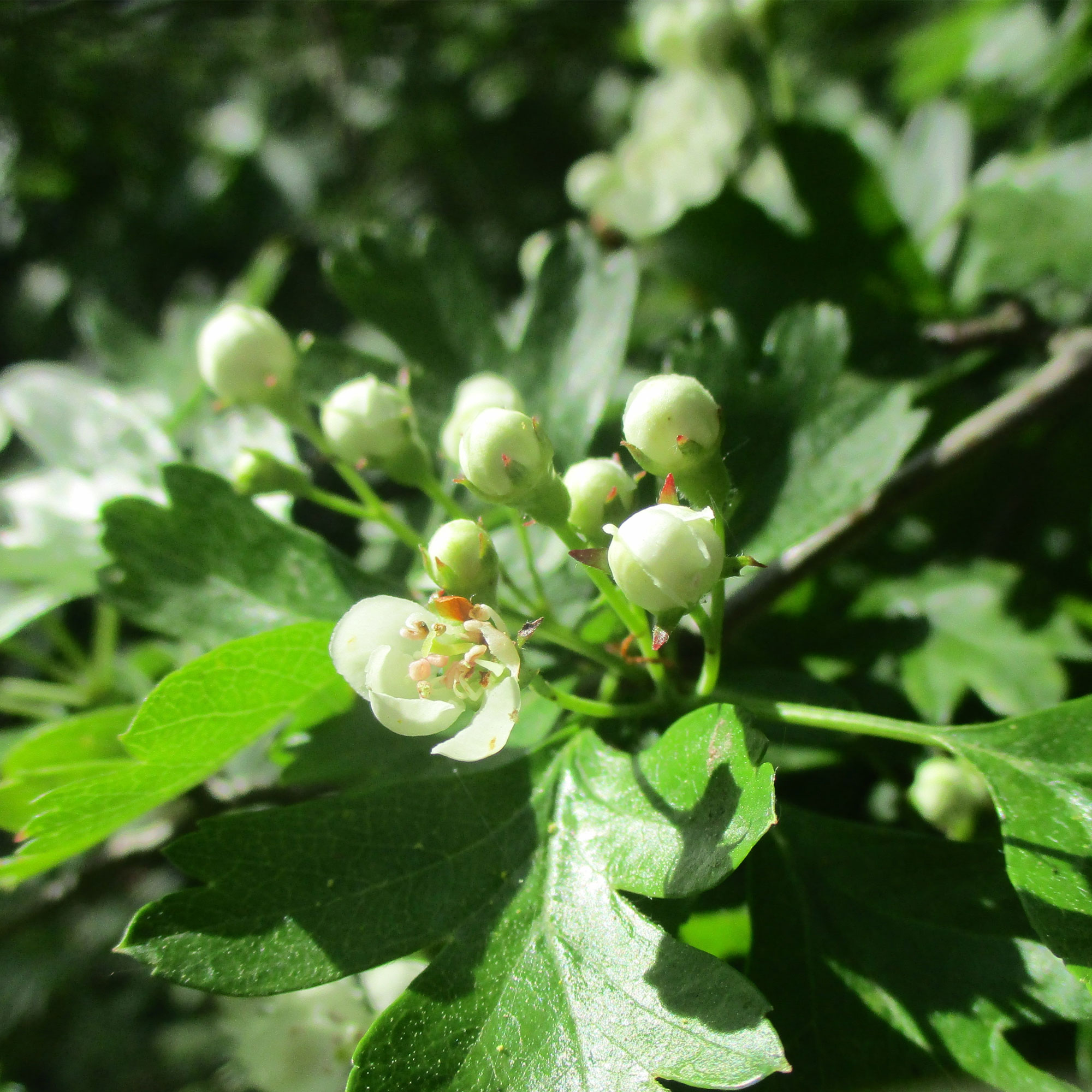Overview
Hawthorn is a thorny deciduous shrub or small tree in the rose family (Rosaceae). It has deeply lobed, toothed leaves, clusters of small white or pink flowers, and bright red spherical berries (haws). Leaves, flowers and berries are used interchangeably as medicine. The plant is common in hedgerows across Europe and North America. Hawthorn is a gentle, safe tonic for the cardiovascular system and supports circulation, heart function, blood pressure and connective tissues. Its sweet, slightly sour taste and cooling, drying energetics make it a valuable adaptogenic herb for emotional balance and healthy blood flow.
Common Name
Family
Genus
Species
Hardiness zone
Status

Parts Used

System Affinity

Preparation Method

Therapeutic Dosage

Tissue States

Energetics

Taste

Safety Class
Traditional Uses
Historically, Crataegus has been used in folk medicine for treating heart weakness, palpitations, and emotional distress—especially when associated with grief or loss. In European herbalism, its affinity with the heart was seen both physically and metaphorically, often prescribed to “mend a broken heart.” The berries were consumed as jams, wines, and syrups, while decoctions of the leaves and flowers were made into restorative tonics for the aged or frail.
Hildegard von Bingen and Nicholas Culpeper referenced hawthorn in their writings, noting its strengthening effect on the heart and spirit. In Traditional Chinese Medicine, hawthorn fruit (Shan Zha) is used to aid digestion, particularly of fatty foods, and to support healthy blood flow.
Clinical Notes
In contemporary herbal practice, Crataegus is most commonly indicated for mild to moderate cardiovascular conditions. It is considered a primary herb for:
-
Congestive heart failure (especially NYHA class I and II)
-
Angina
-
Hypertension (mild to moderate)
-
Post-myocardial infarction recovery
-
Arrhythmias and palpitations
-
Anxiety and nervous tension associated with heart symptoms
It improves coronary circulation, enhances myocardial perfusion, increases contractility, and offers antioxidant protection to cardiac tissue. Clinically, it is well tolerated and can be used alongside conventional cardiovascular medications under supervision.
Crataegus is also valued in formulations addressing the emotional heart—useful in cases of grief, heartbreak, or long-standing emotional suppression. Its gentle nervine action offers a sense of groundedness and resilience.
Medicinal Actions

Nervous System

Endocrine & Hormonal System

Digestive System

Immune & inflammatory System

Reproductive System

Cardiovascular System

Respiratory System

Urinary System

Musculoskeletal & Tissue Repair

Metabolic & Regulatory

General / Systemic
Oncology Note
Crataegus spp. has not traditionally been positioned as a primary oncology herb, but emerging research points toward supportive roles. Its potent antioxidant flavonoids—particularly oligomeric procyanidins (OPCs) and flavonol glycosides—exert cytoprotective effects on cardiac tissues and may offer chemoprotective benefits during or after cancer treatment.
-
Cardioprotection during chemotherapy: Crataegus may help mitigate cardiotoxicity induced by anthracycline drugs such as doxorubicin, primarily via reduction of oxidative stress and lipid peroxidation in cardiac tissue.
-
Potential anti-proliferative effects: Some in vitro studies have demonstrated the ability of hawthorn extracts to inhibit tumour cell growth and angiogenesis, although these effects are not yet clinically substantiated.
-
Immune modulation: Its anti-inflammatory and immunomodulatory properties may support recovery during cancer treatment, especially where cardiovascular comorbidity or frailty is present.
Hawthorn is best viewed in oncology as an adjunctive tonic, particularly in patients recovering from cancer treatments or managing long-term cardiovascular risks.
Contraindications
-
Crataegus is generally considered safe, with a wide therapeutic window, but some cautions apply:
-
Drug interaction potential: Use caution when combining with:
-
Cardiac glycosides (e.g., digoxin), due to possible synergistic enhancement.
-
Antihypertensives or beta blockers—monitor blood pressure closely to avoid hypotension.
-
Nitrates—may enhance vasodilation.
-
-
Hypotension risk: In susceptible individuals or at high doses, Crataegus may cause dizziness or light-headedness from reduced blood pressure.
-
Pregnancy/lactation: No adverse effects have been reported, but clinical safety data is limited. Use under professional supervision.
-
Allergies: Rare allergic reactions have been reported to Crataegus species in sensitive individuals.
-
Therapeutic Indications

Nervous System

Endocrine & Hormonal System

Digestive System

Immune System

Reproductive & Sexual Health

Cardiovascular System

Respiratory System

Urinary System

Musculoskeletal System

Skin Wound & External

Pscyhological, Emotional & Energetic

Constitutional System & Multi System
Phytochemistry
Crataegus spp. (hawthorn) is rich in bioactive constituents that contribute to its cardiovascular, antioxidant, and mild anxiolytic properties. The most pharmacologically important groups include flavonoids, oligomeric procyanidins (OPCs), phenolic acids, and triterpenoids.
1. Flavonoids
-
Vitexin, hyperoside, rutin, quercetin, apigenin, and luteolin are the principal flavonoids.
-
These compounds support vasodilation, capillary integrity, and antioxidant defense.
-
Vitexin-2″-O-rhamnoside is a dominant constituent and marker compound in standardised extracts (e.g. WS 1442).
2. Oligomeric Procyanidins (OPCs)
-
Found mainly in the leaves and flowers.
-
Potent antioxidants; scavenge free radicals and inhibit lipid peroxidation.
-
Support endothelial function, reduce platelet aggregation, and modulate nitric oxide availability.
3. Phenolic Acids
-
Chlorogenic acid, caffeic acid, and ferulic acid.
-
Contribute to anti-inflammatory and vasoprotective effects.
-
May inhibit ACE (angiotensin-converting enzyme), aiding in blood pressure reduction.
4. Triterpenoids
-
Primarily found in the berries.
-
Include ursolic acid, oleanolic acid, and crataegolic acid.
-
These support mild anti-inflammatory and cardioprotective effects.
5. Other Constituents
-
Sterols (e.g., β-sitosterol)
-
Catechins and epicatechins (also contributing to OPC formation)
-
Tannins—mildly astringent, add to gut-toning properties
-
Pectin—contributes to fibre content and gut health support
Pharmacokinetics & Related Drugs
Pharmacokinetics:
-
Absorption: Crataegus flavonoids are absorbed via passive diffusion in the small intestine, with some enterohepatic recycling.
-
Metabolism: Metabolised primarily in the liver by conjugation to glucuronides and sulfates. The bioavailability of individual constituents (e.g., vitexin, hyperoside) varies widely.
-
Elimination: Excreted via urine and bile. Half-life data is limited but likely short for most flavonoids and procyanidins.
Related Drugs:
-
Digoxin: Functional overlap (positive inotropy), though mechanisms differ; co-use must be monitored.
-
ACE inhibitors / Beta blockers / Calcium channel blockers: Crataegus may enhance the hypotensive or heart rate-lowering effects of these drugs.
-
Statins: Though not directly related, Crataegus may support endothelial health and lipid metabolism, offering a complementary approach to statin therapy.
References
-
Bone, K., & Mills, S. (2013). Principles and Practice of Phytotherapy (2nd ed.). Edinburgh: Churchill Livingstone.
-
Hoffmann, D. (2003). Medical Herbalism: The Science and Practice of Herbal Medicine. Rochester, VT: Healing Arts Press.
-
Suter, A., et al. (2006). “Hawthorn extract WS® 1442 in patients with heart failure: A randomized controlled trial.” Phytomedicine, 13(10), 706–714.
-
Pittler, M.H., & Ernst, E. (2003). “Hawthorn extract for treating chronic heart failure: meta-analysis of randomized trials.” Am J Med, 114(8), 665–674.
-
Rigelsky, J.M., & Sweet, B.V. (2002). “Hawthorn: Pharmacology and therapeutic uses.” Am J Health-Syst Pharm, 59(5), 417–422.
-
Wang, X., et al. (2013). “Cardioprotective effects of flavonoids from hawthorn on isoproterenol-induced myocardial infarction in rats.” J Ethnopharmacol, 150(1), 521–528.
-
European Medicines Agency (EMA). (2016). Assessment report on Crataegus monogyna Jacq. and/or Crataegus laevigata (Poir.) DC., EMA/HMPC/159076/2014.

